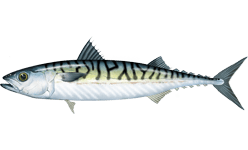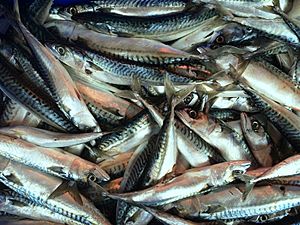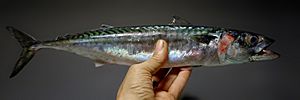Atlantic mackerel facts for kids
Quick facts for kids Atlantic Mackerel |
|
|---|---|
 |
|
| Scientific classification | |
| Kingdom: | |
| Phylum: | |
| Class: | |
| Order: | |
| Family: | |
| Genus: |
Scomber
|
| Species: |
S. scombrus
|
| Binomial name | |
| Scomber scombrus |
|
The Atlantic mackerel (its scientific name is Scomber scombrus) is a type of mackerel fish. It loves to swim in huge groups, called schools, in the open ocean. You can find it on both sides of the North Atlantic Ocean. Some people also call it the Boston mackerel.
It's one of the most common types of mackerel caught near British waters. These fish gather in huge groups, called shoals, and swim towards the coast in the summer. They do this to find small fish and shrimp to eat.
Atlantic mackerel are very common in cold and mild ocean areas near the continental shelf. They form large schools close to the water's surface. In winter, they move to deeper waters. But in spring, when the water gets warmer (around 11° to 14°C), they swim closer to shore.
In the north-east Atlantic, like the North Sea and near the British Isles, their numbers dropped a lot in the 1960s. This happened because too many were caught by fishing.
Male and female Atlantic mackerel grow at about the same speed. They can live for about 20 years. The longest they usually get is about 47 centimetres (19 inches). Most Atlantic mackerel are ready to have babies by the time they are three years old.
Contents
What Does an Atlantic Mackerel Look Like?
The Atlantic mackerel has a long, sleek body that tapers at both ends. Its snout is long and pointed. It has big eyes covered by a special eyelid. Its teeth are small, sharp, and cone-shaped.
Its scales are tiny, making the fish feel smooth, almost like velvet. The only bigger scales are right behind its head and around its pectoral fins (the ones on its sides).
It has two large dorsal fins (on its back) that are far apart. After the second dorsal fin, there are usually 5 small finlets. The anal fin (on its belly) is similar in size and shape to the second dorsal fin and also has 5 finlets.
The fish's body gets thinner towards its tail. The short but wide tail fin is attached to this slim part. The top of its body is a steel-blue color with wavy black lines. The rest of its body is silvery-white or yellow. It might also have darker spots.
Atlantic mackerel can grow up to 60 centimetres (24 inches) long. A common length is about 30 centimetres (12 inches). The heaviest one ever recorded weighed about 3.4 kilograms (7.5 pounds).
Where Do Atlantic Mackerel Live?
The Atlantic mackerel lives in the western Atlantic Ocean from Labrador, Canada, down to Cape Lookout, North Carolina. In the eastern Atlantic, you can find it from Iceland all the way south to Mauritania. It also lives in the Mediterranean, Black, and Baltic Seas.
They prefer water temperatures above 8°C (46°F). However, they are often found in waters as cold as 7°C (45°F). Sometimes, though rarely, they can be found in water as cold as 4.5°C (40°F). Atlantic mackerel usually swim from the surface down to 200 metres (660 feet) deep. But some have been found as deep as 1,000 metres (3,300 feet).
Migration Habits
Atlantic mackerel are fish that travel a lot. In spring and summer, they swim closer to shore, usually about 32 to 161 kilometres (20 to 100 miles) out. Younger fish tend to swim even closer to the coast than adults. Sometimes, young fish even enter harbors.
In fall and winter, they move farther out into the ocean and south to warmer waters. They stay near the edge of the continental shelf. They first arrive on the North American coast in April, at the southern part of their range. By July, they are found along the entire coast.
They start moving back out to sea in September. By December, they are completely gone from the coast. There is much more food available for them during the summer. Because of this, they have the most fat on their bodies in August. This is just four months after their lowest fat point in April.
Atlantic Mackerel and People
| Nutritional value per 100 g (3.5 oz) | |
|---|---|
| Energy | 858 kJ (205 kcal) |
|
0 g
|
|
|
14 g
|
|
|
Protein
|
19 g
|
| Vitamins | Quantity
%DV†
|
| Vitamin A equiv. |
6%
50 μg |
| Choline |
13%
65 mg |
| Vitamin D |
107%
643 IU |
| Minerals | Quantity
%DV†
|
| Calcium |
1%
12 mg |
| Iron |
13%
1.63 mg |
| Magnesium |
21%
76 mg |
| Phosphorus |
31%
217 mg |
| Potassium |
10%
314 mg |
| Zinc |
7%
0.63 mg |
| Other constituents | Quantity |
| Water | 64 g |
| †Percentages estimated using US recommendations for adults. | |
The Atlantic mackerel is very important for fishing businesses in the Atlantic. Fishermen catch them using large nets like purse seines and trawls, or with gill nets and fishing lines. Each year, about 1 million tonnes of Atlantic mackerel are caught around the world. In 2014, this number jumped to almost 1.5 million tonnes!
The United Kingdom and Norway catch the most Atlantic mackerel. Each country brings in over 160,000 tonnes every year. There are different groups, called stocks, of Atlantic mackerel in the eastern Atlantic and two in the western Atlantic. There are also two groups in the Mediterranean Sea.
Eating Atlantic Mackerel
The outer part of Atlantic mackerel meat is red, while the inner part is white. It has a strong taste that some people really enjoy. You can buy them fresh, frozen, smoked, or salted. They are also sold as fillets or steaks.
This fish is very healthy for you! It has a lot of oil, vitamin B6, vitamin B12, selenium, niacin, and omega 3. Omega-3s are a type of healthy fatty acid. Atlantic mackerel has almost twice as much omega-3 per serving as salmon.
Unlike some other types of mackerel, like the King or Spanish mackerel, Northern Atlantic mackerel have very low levels of mercury. This means you can safely eat them at least twice a week, according to guidelines from the United States Environmental Protection Agency.
See also
 In Spanish: Caballa del Atlántico para niños
In Spanish: Caballa del Atlántico para niños




